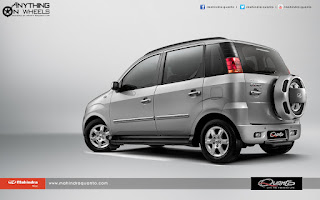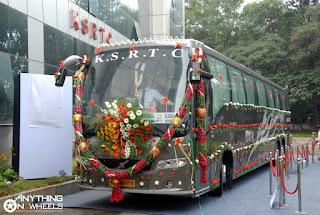The Tata Indigo eCS is not a new car in the market. Launched in 2010, it was targeted squarely at the taxi segment initially. When Tata wanted to attract private buyers as well, they quietly slipped in an additional VX variant with more features inside and out. Even this happened late last year. But why are we driving and posting about it now? There is a reason. To tackle the triple whammy of sky-rocketing gasoline prices, rising interest rates and decreasing market sentiment, customers are running after diesel power, fuel-efficiency and value for money. The Indigo eCS ticks all these and some more. That it comes with the added practicality of a boot without charging a substantial premium is just an added bonus.
Are we looking at ‘the perfect car’ then for the prevailing market conditions? Well, read on to find out.
TO LOOK AT:


If there is one thing that Tata has to do immediately to increase footfalls in their showrooms, they have to come up with a new design language. We have grown tired of looking at their cars and are pretty sure that most of you are too. The signature ‘smiling’ grille and the all-too-familiar triangular headlights do nothing to evoke interest. Though the satin-silver finish in the grille, the chrome lip and the clear detailing in the headlights try their best to brighten things up, there is only so much that can be done to a more-than-a-decade-old design. In profile, the Indigo eCS is a carbon copy of Indica until the rear doors, which isn’t bad. But things that change after that doesn’t necessarily change for the better though. Tata’s deliberate attempt to chop off the length of the car to bring it under 4 meters has resulted in a short and stubby boot that looks odd and disproportionate from most angles.

The top-end VX variant that we got to drive was added to the Indigo eCS line-up primarily to woo private buyers. Accordingly, it gets a host of visual embellishments that aims to make the car a bit more classy and functional. The grille with its satin finish looks good, as does the snazzy alloys. Thankfully, Tata has played it subtle with the chrome bits and didn’t go overboard like a few of its competitors. Though rear view mirrors with blinkers are added to the VX variant, the blinkers in the fenders aren’t taken off. So, you have not one but two blinkers on either side, which is odd.
Hopefully, Tata is working on CS variants of Manza which would be better and modern than the eCS.
TO SIT IN:


The first thing that strikes you once you step into the Indigo eCS is the abundance of space, relative to other cars in this segment. Both the front and rear seats have more than adequate headroom and legroom and the rear seat can accommodate three abreast quite comfortably. Just like the exteriors, there are a host of features exclusive to the VX variant inside as well. The dashboard and plastics are finished in beige which makes the cabin feel quite airy. Then there is this wooden finish in the center console and door handles that we didn’t like at all. The instrument cluster is new, with two prominent chrome-ringed dials and the rear seat also gets a center armrest. Creature comforts such as keyless entry, Bluetooth connectivity and electrically-adjustable rear view mirrors makes the car quite well equipped for the price. Though Antilock Braking System (ABS) is available as standard, Airbags aren’t even optional.


The major grouse with all Tata cars is their sub-par levels of build quality and poor fit and finish. The Indigo eCS VX sadly is no exception. The vertical chrome strip in the steering wheel that looks like a school-going kid's craft work, the wooden inserts that was broken at a couple of places and all those exposed wires in the driver's footwell are irritants that could spoil the entire ownership experience. Ergonomics has gone for a toss too. The pedals are placed at an awkward angle that it starts hurting your feet in just a few minutes and the lesser said about the position of power window switches, the better.
Tata still has a very long way to go to match the build quality offered by its immediate rivals Maruti-Suzuki and Hyundai.
TO DRIVE:


Ever since the Indigo CS was launched in 2008, Tata continuously worked on it and came out with improved versions every now and then. The eCS VX is probably the summit of all those work done by Tata. There are a series of changes under the hood aimed at reducing the losses and improving the efficiency. ECU has been recalibrated, gear ratios have been changed, fuel delivery has been reworked and the air-fuel mixture has been optimized resulting in an astounding ARAI-certified fuel efficiency figure of 25 km/l. That makes the Indigo eCS one of India's most fuel-efficient cars on paper. On real world conditions, the car returned somewhere close to 18 km/l, which is still mighty impressive. This 1396 cc common-rail turbo diesel engine, dubbed CR4, produces a maximum power of 69 bhp at 4000 rpm and a peak torque of 14.2 kgm at 1800 to 3000 rpm. Refinement levels, though not the best in segment, are adequately good.

Power delivery is linear with virtually no turbo kick and the car feels sprightly with good bottom and mid-range, making city driving easier. The car struggles at the top of its power band though and overtaking manouerves in highways needs to be adequately planned if you don't want to get caught out by the lack of surge. The car is an excellent highway cruiser but only up to speeds in the range of 80 to 90 km/hr. Anything more than that and the car tends to resist with a lot of wind noise intruding inside the cabin and the engine feeling strained and noisy. Gearshifts are far from impressive with the long throws and rubbery feel spoiling the feel.

Except for a slightly jittery low speed ride courtesy the stiffer suspension setup and the low rolling resistance tires, the Indigo eCS possesses a very good ride quality that soaks up bumps and potholes without much of a fuss. Handling has never been Tata's forte and this car proves it again. Though straight line stability is good, the rear gets bouncy when you throw the car into a corner. Though the brake pedal is spongy and responds after a slight delay, presence of ABS ensures that the car comes to a stop without losing its line.
SPECIFICATIONS (VX):
* Engine Type: CR4 In-line, Common-rail Turbo Diesel
* No of Cylinders: 4
* Displacement: 1396 cc
* Maximum Power: 69 bhp @ 4000 RPM
* Maximum Torque: 14.2 kgm @ 1800-3000 RPM
* Transmission Type: 5-speed MT
* Tires: 175/65 R14
* Brakes: Ventilated Disc (Front), Drum (Rear)
WE VOTE FOR:
* Amazing fuel-efficiency
* Spacious Cabin
* Real value for money
WE VOTE AGAINST:
* Sub-par build-quality, fit and finish
* Dated exteriors and interiors
TO SUM UP:


The Indigo eCS VX has its own set of flaws. It looks dated inside and out, it's build quality leaves a lot to be desired and Tata's after-sales service is nowhere near where it needs to be. But where the car really scores is with what the masses are looking for. It is cheap to own, run and maintain, is incredibly fuel-efficient, comes loaded with an interesting mix of features and is an excellent highway cruiser.
So, here is our answer to the question raised at the beginning of this post. The Tata Indigo eCS VX is still not 'the perfect car', but it comes scarily close to meeting all the current market demands to the tee. If ever there was proof needed that Tata does read the hearts and minds of Indians perfectly, this is it!








































